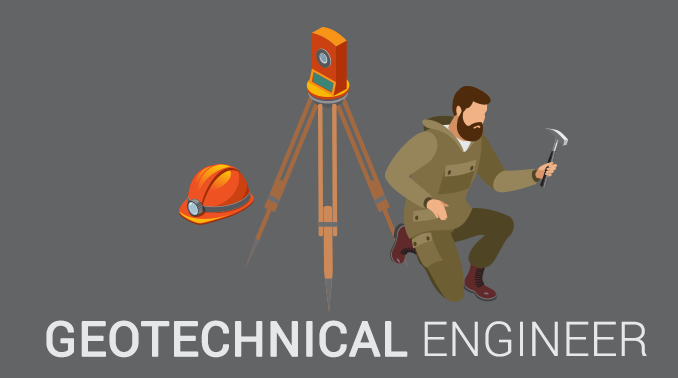Top Guidelines Of Geotheta
Top Guidelines Of Geotheta
Blog Article
How Geotheta can Save You Time, Stress, and Money.
Table of ContentsSome Known Incorrect Statements About Geotheta The Ultimate Guide To GeothetaThe 20-Second Trick For GeothetaSome Of Geotheta
They work together with civil designers, structural engineers, designers, and various other experts to incorporate geotechnical factors to consider into the general task layout and construction procedure. This calls for efficient teamwork, control, and communication to ensure that the geotechnical elements align with the job purposes and fulfill regulatory demands.Mining & Materials Design: Principles of boring, infiltration rates, and variables affecting the option of boring technique. Characteristics of dynamites, shooting systems and blast patterns. Blowing up techniques in surface area and underground functions. Unique blasting techniques at excavation borders. Resonance and noise control. Mechanical and continual strategies to fragmentation, consisting of longwall shearing and fullface boring.
Modelling of piece and bit dimension distributions; comminution as a transfer feature. Comminution technology: crushing, grinding, size classification. Integrated evaluation of fragmentation and comminution operations. Used by: Mining & Products Design.
The smart Trick of Geotheta That Nobody is Talking About
Bachelor's degree programs in civil, geotechnical, geological, and environmental design normally last 4 years and consist of general education programs in English, social scientific research, and the liberal arts, as well as courses in advanced mathematics, structural geology, and liquid mineralogy. (https://www.merchantcircle.com/blogs/geotheta-miami-fl/2024/8/Why-Geotechnical-Engineers-at-Geotheta-Are-Your-Best-Bet/2781881)
Geotechnical engineering entails the assessment of the soil and rock conditions at a specific website, and their implications for the development of that site. As the majority of structures count on the ground for assistance, it is without surprise that an in-depth understanding of the ground problems, and the viability of structure systems, are important to the long-term security and efficiency of the structure or framework.
Being experts in the examination of geological developments and ground practices, geotechnical designers carry out scientific investigations and screening to understand the influence these geological developments might carry the design and building of structure, civil and facilities tasks. This competence is critical for the layout and building and construction of structures, roadways, passages, dams, bridges, and water system and sewer system.
The geotechnical group at Douglas Partners regularly seek advice from designers, design engineers, developers, and contractors to make referrals on style and growth propositions to make sure that the developed structures are suitably designed for the ground problems. As an example, the layout of footing systems requires to think about the weight of the structure, the ability of the ground to support that weight along with motion tolerances and efficient building and construction.
Little Known Facts About Geotheta.
This job is considerably simplified by the usage of our Douglas Map geospatial system that makes this info easily available in a browse around these guys very easy to use internet browser interface. A geotechnical designer will route the boring of boreholes and examination pits to accumulate soil and other samples, and likewise analyze surface features and ground exposures to form a geotechnical version of the subsurface problems.
Relying on the task type and ground problems experienced, laboratory screening might to name a few things examine stamina, compressibility, sensitivity and/or leaks in the structure of soil and rock samples. After this data is accumulated and collected, the outcomes are utilized for a geotechnical model of the site, which is commonly presented as sections throughout the website.

A geotechnical examination naturally can just examine the ground conditions at the areas pierced or dug deep into. All-natural variants in dirt and rock problems can take place across a site and in between test areas. It is for that reason great practice that the geotechnical designer be kept throughout construction of the job to supply on-site verification that the ground problems run into follow the expectations and suggestions provided in the geotechnical examination report.
6 Easy Facts About Geotheta Explained
Geotechnical engineers utilize their in-depth understanding of soil and rock to examine risk and solve problems on diverse infrastructure projectsGeotechnical engineering is a specialist branch of civil design which takes a look at the behavior of earth materials and the application of soil and rock mechanics. Geo Tech Engineering. As a geotechnical engineer, you will certainly examine the physical, mechanical and chemical buildings of dirt and rock in order to make foundations, maintaining structures and earthworks
Geotechnical design is very closely linked to and overlaps with, both design geology and ground design - https://www.huntingnet.com/forum/members/geotheta.html. It's feasible to be experts in geotechnics or help a geotechnical company yet be referred to as an engineering geologist or a ground engineer. As a geotechnical engineer, you'll need to: construct and keep partnerships with clients and various other experts entailed in the website, throughout each projectmaintain safety standards on site be mindful of cost ramifications when you make recommendationsstudy geological maps and airborne photos from a variety of sources and from different time periodsexamine construction plans to see how possible they are based on your understanding of the siteinvestigate dangers or geological threats for the sitesearch for eco delicate functions, such as land fill start to establish factual and interpretive ground modelsplan area investigationsdrill and evaluate samples of bedrock, dirt, groundwater and additional materials supervise various other experts on sitesolve technological issues as they develop, such as unanticipated structures at drill sitesmonitor conditions throughout and after construction to make certain structures are secure in the short and lengthy termadding information accumulated on site to your preliminary researchcreating geotechnical calculations, drawings, and two or three-dimensional computer designs analyzing the datamaking recommendations about the suggested use the website

Report this page